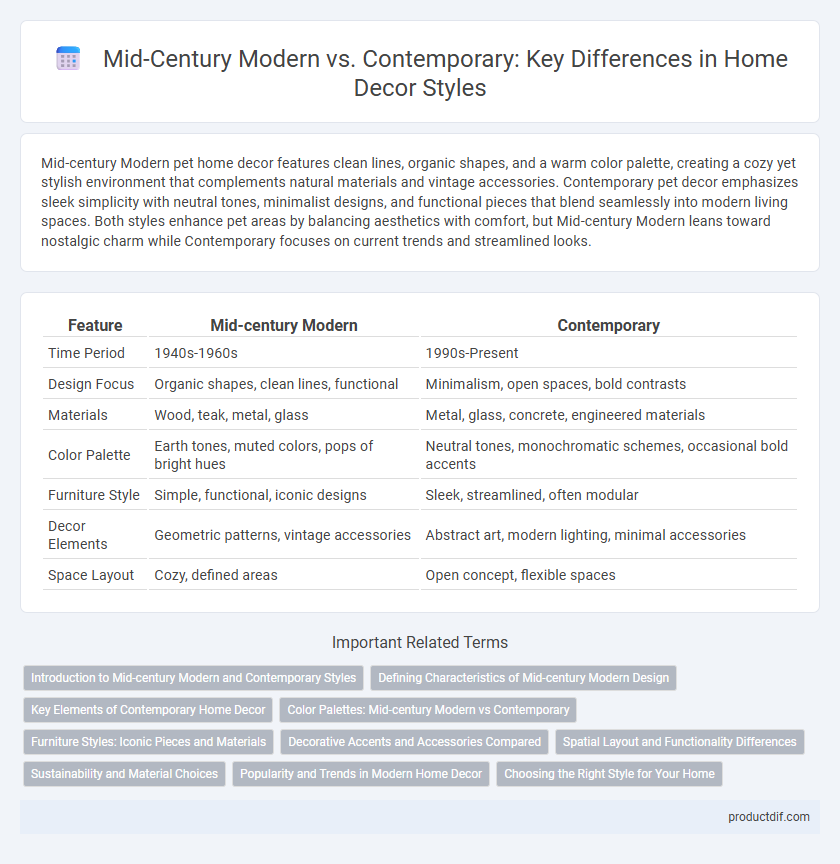Mid-century Modern pet home decor features clean lines, organic shapes, and a warm color palette, creating a cozy yet stylish environment that complements natural materials and vintage accessories. Contemporary pet decor emphasizes sleek simplicity with neutral tones, minimalist designs, and functional pieces that blend seamlessly into modern living spaces. Both styles enhance pet areas by balancing aesthetics with comfort, but Mid-century Modern leans toward nostalgic charm while Contemporary focuses on current trends and streamlined looks.
Table of Comparison
| Feature | Mid-century Modern | Contemporary |
|---|---|---|
| Time Period | 1940s-1960s | 1990s-Present |
| Design Focus | Organic shapes, clean lines, functional | Minimalism, open spaces, bold contrasts |
| Materials | Wood, teak, metal, glass | Metal, glass, concrete, engineered materials |
| Color Palette | Earth tones, muted colors, pops of bright hues | Neutral tones, monochromatic schemes, occasional bold accents |
| Furniture Style | Simple, functional, iconic designs | Sleek, streamlined, often modular |
| Decor Elements | Geometric patterns, vintage accessories | Abstract art, modern lighting, minimal accessories |
| Space Layout | Cozy, defined areas | Open concept, flexible spaces |
Introduction to Mid-century Modern and Contemporary Styles
Mid-century Modern style features clean lines, organic curves, and a focus on functionality, originating from the mid-20th century between the 1940s and 1960s. Contemporary style emphasizes current trends with an open, minimalistic approach, using neutral colors, smooth textures, and innovative materials. Both styles prioritize simplicity and practicality but differ in historical influence and evolving design elements.
Defining Characteristics of Mid-century Modern Design
Mid-century Modern design is characterized by clean lines, organic curves, and a seamless blend of form and function, emphasizing simplicity and minimal ornamentation. This style often features natural materials such as wood, leather, and metal, combined with vibrant colors and geometric patterns to create a warm yet sleek aesthetic. Iconic furniture pieces from designers like Charles and Ray Eames and Eero Saarinen highlight this era's focus on innovative craftsmanship and timeless versatility.
Key Elements of Contemporary Home Decor
Contemporary home decor emphasizes clean lines, open spaces, and a neutral color palette often accented with bold, strategic pops of color. Key elements include minimalist furniture with smooth surfaces, natural light to enhance the sense of space, and a blend of textures such as glass, metal, and wood to create visual interest. Unlike Mid-century Modern's organic shapes and warm tones, Contemporary style prioritizes simplicity, functionality, and a constantly evolving aesthetic influenced by current trends.
Color Palettes: Mid-century Modern vs Contemporary
Mid-century Modern color palettes emphasize warm, earthy tones such as mustard yellow, olive green, and burnt orange, often combined with natural wood finishes to create a cozy, nostalgic ambiance. Contemporary palettes favor neutral shades like white, gray, and black, punctuated with bold accent colors such as cobalt blue or bright red to achieve a sleek, minimalist look. Both styles use color strategically to complement their distinct design principles, with Mid-century Modern embracing vintage warmth and Contemporary showcasing modern sophistication.
Furniture Styles: Iconic Pieces and Materials
Mid-century Modern furniture features iconic pieces like the Eames lounge chair and Noguchi coffee table, characterized by organic shapes, teak wood, and molded plywood materials. Contemporary furniture emphasizes clean lines, minimalist silhouettes, and incorporates materials such as metal, glass, and engineered wood for a sleek, functional aesthetic. Both styles prioritize comfort and craftsmanship but differ in their approach to form and material innovation within home decor.
Decorative Accents and Accessories Compared
Mid-century Modern decorative accents emphasize organic shapes, warm wood tones, and minimalist designs often featuring tapered legs and geometric patterns. Contemporary accessories prioritize sleek materials like metal and glass, with a focus on bold colors, clean lines, and abstract forms that create a sense of openness and modernity. Both styles use decorative elements to enhance aesthetic appeal, but Mid-century Modern favors vintage-inspired warmth, while Contemporary embraces futuristic simplicity.
Spatial Layout and Functionality Differences
Mid-century Modern design emphasizes open spaces with a focus on functionality, often featuring furniture with minimal ornamentation and organic shapes that promote flow and ease of movement. Contemporary layouts prioritize flexible, multi-functional spaces with clean lines and a minimalist approach, adapting swiftly to evolving lifestyle needs. The spatial configuration in Mid-century Modern homes fosters a warm, inviting environment, while Contemporary designs leverage technology and modular elements for enhanced practicality.
Sustainability and Material Choices
Mid-century Modern design features natural materials like wood, leather, and metal, emphasizing durability and timeless appeal that supports sustainability through longevity. Contemporary decor often incorporates eco-friendly, recycled, and renewable materials, including bamboo, reclaimed wood, and low-VOC finishes, prioritizing environmental impact and resource efficiency. Both styles promote sustainability but differ in material sourcing and the balance between traditional craftsmanship and innovative, green technology.
Popularity and Trends in Modern Home Decor
Mid-century Modern remains highly popular in modern home decor due to its iconic clean lines, organic shapes, and functional aesthetics that evoke a timeless retro appeal. Contemporary design trends emphasize sleek, minimalist elements and neutral color palettes, appealing to homeowners seeking versatile and adaptable spaces. Consumer preference leans toward integrating mid-century pieces as statement accents within contemporary interiors, blending nostalgic charm with current sophistication.
Choosing the Right Style for Your Home
Mid-century Modern emphasizes clean lines, organic shapes, and functional design drawn from the 1940s to 1960s, making it ideal for those who appreciate vintage aesthetics and timeless simplicity. Contemporary style embraces current trends, featuring sleek surfaces, minimalist forms, and neutral palettes suited for homeowners seeking a fresh, adaptable look. Selecting between Mid-century Modern and Contemporary depends on personal taste, desired ambiance, and the architectural context of your space.
Mid-century Modern vs Contemporary Infographic

 productdif.com
productdif.com